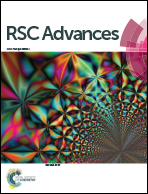The novel and facile preparation of multilayer MoS2 crystals by a chelation-assisted sol–gel method and their electrochemical performance
Abstract
Multilayer molybdenum disulfide (MoS2) was facilely prepared by a chelation-assisted sol–gel method with ammonium molybdate tetrahydrate ((NH4)6Mo7O24·4H2O) as the molybdenum source, thioacetamide (CH3CSNH2) as the sulfur source and diethylenetriamine pentaacetic acid (Dtpa) as the chelating agent, subsequently followed by high-temperature calcination. The chelating agent Dtpa ingeniously mediated the chelation reaction of the system and promoted the formation of a monolithic gel. The hexagonal MoS2 crystal (2H-MoS2) with good crystallinity precipitated after calcination at 1000 °C with the Mo and S mass ratio of 1 : 3. The adjustable MoS2 layers stacked together to form MoS2 flakes, and these flakes aggregated to construct crystalline MoS2 particles. The electrochemical tests showed the possibility of as-prepared MoS2 crystals applied as a negative electrode for lithium ion batteries.



 Please wait while we load your content...
Please wait while we load your content...